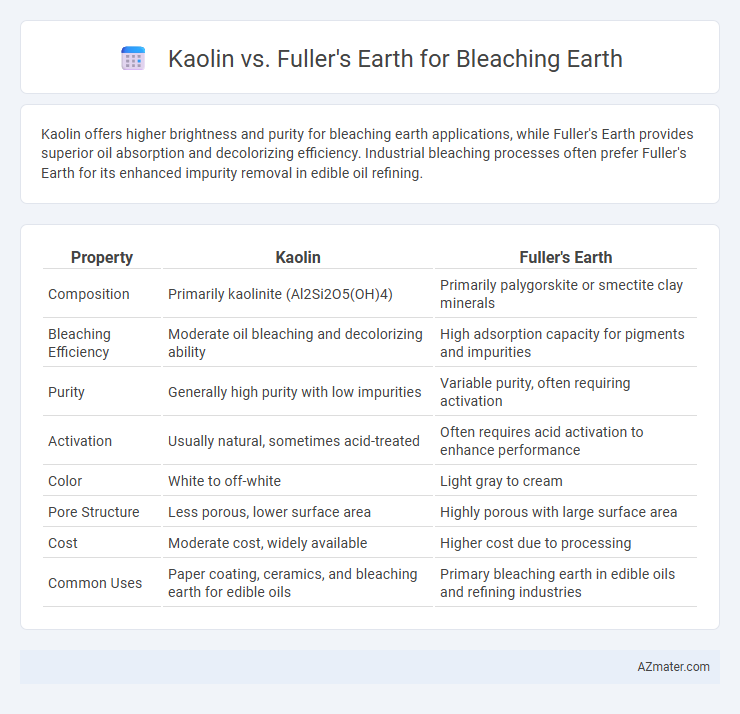Kaolin offers higher brightness and purity for bleaching earth applications, while Fuller's Earth provides superior oil absorption and decolorizing efficiency. Industrial bleaching processes often prefer Fuller's Earth for its enhanced impurity removal in edible oil refining.
Table of Comparison
| Property | Kaolin | Fuller's Earth |
|---|---|---|
| Composition | Primarily kaolinite (Al2Si2O5(OH)4) | Primarily palygorskite or smectite clay minerals |
| Bleaching Efficiency | Moderate oil bleaching and decolorizing ability | High adsorption capacity for pigments and impurities |
| Purity | Generally high purity with low impurities | Variable purity, often requiring activation |
| Activation | Usually natural, sometimes acid-treated | Often requires acid activation to enhance performance |
| Color | White to off-white | Light gray to cream |
| Pore Structure | Less porous, lower surface area | Highly porous with large surface area |
| Cost | Moderate cost, widely available | Higher cost due to processing |
| Common Uses | Paper coating, ceramics, and bleaching earth for edible oils | Primary bleaching earth in edible oils and refining industries |
Introduction to Bleaching Earths: Kaolin vs Fuller’s Earth
Bleaching earths, primarily used for refining edible oils and fats, differ significantly between kaolin and Fuller's earth based on their mineral composition and adsorption capacity. Kaolin, rich in kaolinite clay minerals, offers moderate bleaching efficiency with lower impurity absorption, while Fuller's earth, which contains higher montmorillonite content, provides superior adsorption of pigments and impurities. The choice between kaolin and Fuller's earth impacts processing efficiency, oil quality, and cost-effectiveness in the bleaching step of oil refining.
Chemical Composition: Kaolin vs Fuller’s Earth
Kaolin and Fuller's Earth differ significantly in chemical composition, impacting their effectiveness as bleaching earth. Kaolin primarily consists of the mineral kaolinite (Al2Si2O5(OH)4), with minimal impurities, providing a fine, chemically inert clay that excels in adsorption and filtration. Conversely, Fuller's Earth contains a mixture of minerals including montmorillonite, attapulgite, and a higher content of magnesium and iron oxides, offering increased adsorptive capacity for removing impurities and pigments in vegetable oils.
Physical Properties Comparison
Kaolin and Fuller's Earth differ significantly in their physical properties relevant to bleaching earth applications. Kaolin exhibits a finer particle size with high whiteness and low abrasiveness, enhancing its suitability for delicate oil bleaching processes. Fuller's Earth, characterized by higher adsorption capacity and greater porosity, excels in removing impurities but may have coarser particles affecting filtration efficiency.
Adsorption Mechanisms in Bleaching
Kaolin and Fuller's Earth differ significantly in adsorption mechanisms when used as bleaching earth. Kaolin primarily exhibits physical adsorption due to its layered silicate structure and limited surface area, making it less effective in removing impurities. Fuller's Earth, with its higher surface area, porous structure, and active sites such as hydroxyl groups, facilitates stronger chemisorption and ion exchange, leading to superior bleaching performance by adsorbing pigments, oils, and other contaminants more efficiently.
Effectiveness in Oil and Fat Refining
Kaolin and Fuller's Earth are widely used as bleaching earths with differing effectiveness in oil and fat refining; Fuller's Earth demonstrates superior adsorption capacity for impurities such as pigments, phospholipids, and trace metals, enhancing oil clarity and stability. Kaolin, while less adsorptive, offers better filtering properties and is preferred for oils requiring minimal deodorization. The choice between these bleaching earths depends on the specific refining requirements, including impurity load and desired oil quality.
Industrial Applications and Uses
Kaolin and Fuller's Earth are essential materials in the bleaching earth process, primarily used to remove impurities and color from oils, fats, and chemicals in industries such as food processing, cosmetics, and pharmaceuticals. Kaolin is prized for its high purity and fine particle size, making it effective in enhancing oil clarity and stability, while Fuller's Earth, known for its superior adsorptive properties, excels in removing heavy metals and organic contaminants. Industrial applications leverage the distinct adsorption capacities of both clays to achieve optimal bleaching efficiency, resulting in higher quality and more marketable end products.
Environmental Impact and Sustainability
Kaolin and Fuller's Earth differ significantly in their environmental impacts when used as bleaching earth; Fuller's Earth mining often leads to greater habitat disruption and higher water consumption due to its extensive extraction processes. Kaolin, characterized by a lower ecological footprint, benefits from more sustainable mining practices and generates less soil erosion and air pollution. Choosing Kaolin supports environmental sustainability by minimizing resource depletion and promoting rehabilitation of mining sites.
Cost Analysis and Economic Feasibility
Kaolin and Fuller's Earth differ significantly in cost and economic feasibility when used as bleaching earth in oil refining; Kaolin generally incurs higher raw material and processing expenses due to its finer particle size and intensive treatment requirements. Fuller's Earth offers a more cost-effective alternative, providing comparable bleaching performance at a lower market price and reduced energy consumption during activation. Economic analysis favors Fuller's Earth for large-scale industrial applications, as its lower capital and operational costs enhance profitability without compromising adsorption efficiency.
Limitations and Challenges
Kaolin and Fuller's Earth both serve as bleaching earths but present distinct limitations; Kaolin often exhibits lower adsorption capacity, reducing its efficiency in removing pigments and impurities from oils. Fuller's Earth, while more adsorptive, can suffer from inconsistent quality and higher abrasion, leading to increased filter aid consumption and potential equipment wear. Both materials challenge industrial applications by requiring careful processing and regeneration to maintain optimal bleaching performance and cost-effectiveness.
Conclusion: Choosing the Right Bleaching Earth
Kaolin and Fuller's Earth differ significantly in their bleaching efficiency and adsorption capacity, with Fuller's Earth typically offering superior oil refining performance due to its higher surface area and active mineral content. Selecting the right bleaching earth depends on the specific oil type, desired purity level, and cost considerations, where Fuller's Earth is preferred for effective decolorization and impurity removal. For optimal results, evaluating the physical and chemical properties of both materials aligns with processing requirements and environmental regulations.

Infographic: Kaolin vs Fuller’s Earth for Bleaching Earth
 azmater.com
azmater.com